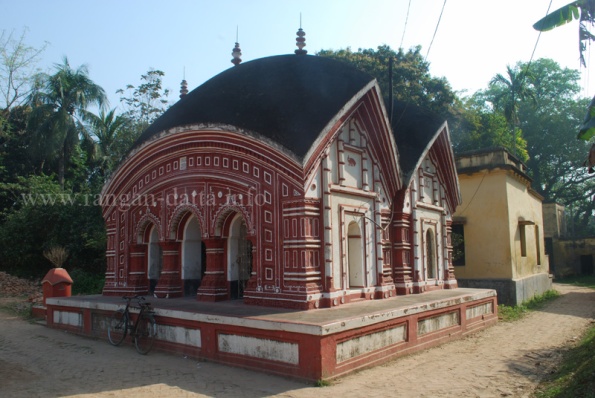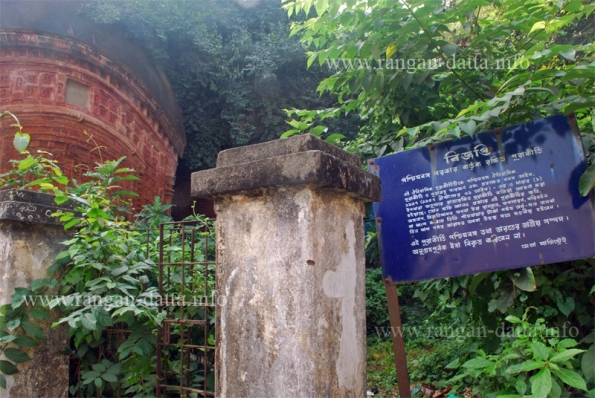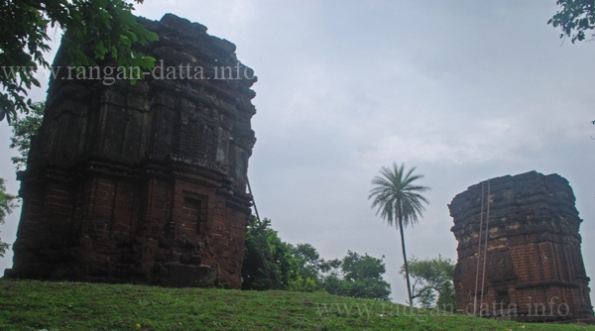Archive
Sukharia ~ Restoration of Harsundari and Nistarini Temple
Sukharia, Somra Bazar, Hooghly
Restoration of Harsudari and Nistarini Kali Temple
See also: My blog post Mitra Mustafi Trilogy
The quint little village of Sukharia, located next to the Somra Bazar station, on the Bandel – Katwa rail line houses an amazing collection of temples and huge mansions.
Hadal Narayanpur ~ Amazing Terracotta Beyond Bishnupur
Hadal Narayanpur
Amazing Terracotta Beyond Bishnupur
See also: Bishnupur Temple Town and Beyond Bishnupur
Bushnupur has always been considered as the Terracotta capital of West Bengal. But the terracotta temple art have spread far beyonds the limits of Bishnupur and several of the villages surrounding Bishnupur houses many spectacular terracotta temples.
Joypur, Dihar, Bahulara, Gokulnagar and Sonamukhi definitely deserves a mention but the village thats stands out is Hadal Narayanpur. This twin villages has the distinction of housing several terracotta temples with the most intricate and delicate carvings.
Ula Birnagar, Forgotten Mansons and Temples
Ula Birnagar
Forgotten Mansions and Temples
See also: My blog post Mitra Mustafi Trilogy
Stone has always been in short supply in the vast flood plains of Bengal. Hence the architects had to restore to other substitute. As clay was easily available the burnt clay bricks soon became a good substitute of stone. This gave rise to a new form of temple architecture
This also lead to the development of a distinctive temple architecture, where God’s didn’t dwell in towering structure but in structures similar to the homes of common man. Thatched roof soon became an indispensible part of Bengal Temple Architecture.
Bishnupur, Temple Town
Bishnupur
Temple Town
Stone has always been in short supply in the vast flood plains of Bengal. Hence the architects had to restore to other substitute. As clay was easily available the burnt clay bricks soon became a good substitute of stone. This gave rise to a new form of temple architecture and lead to the construction of elaborately decorated terracotta temples.
Terracotta literally means baked earth in Italian but West Bengal has the distinction of housing some of the finest terracotta art in the world. The terracotta art reached its pinnacle under the patronage of the Malla Kings of Bishnupur during the seventeenth century.
Dihar ~ Ruined Twin Temples
Dihar ~ Ruined Twin Temples
Near Bishnupur, Bankura, West Bengal
Also see: Beyond Bishnupur ~ Brick and Stone Temples
Located 8 km from Bishnupur, on the Bishnupur – Sonamukhi highway, the village of Dihar houses two ruined but majestic temples. Both the temples are dedicated to Lord Shiva and are known as Sareswar and Saileswar. A Nandi Bull guards the entrance of Sareswar Temple.
Sribati ~ West Bengal’s Hidden Terracotta Gem
Sribati, Katwa, Burdwan
West Bengal’s Hidden Terracotta Gem
Once upon a time a family from far of Gujrat migrated the entire length of the country to settle near the present day town of Katwa in Burdwan district. Belonging to the trader class they soon exhaled in trade & commerce.
Their huge barges sailed up and down the Hooghly and it’s tributaries and distributaries carrying merchandise from far off lands. In a very short span of time the Chandra family earned enough to build themselves a huge mansion, and several temples dedicated to Lord Shiva.
Rajrajeshwar Temple ~ Kotalpur, Hooghly
Rajrajeshwar Temple ~ Kotalpur, Hooghly
~ Unusual Terracotta Panels ~
The Parsis leave their dead bodies for the vulture to eat but for the Hindus vultures have always been considered as a symbol of misfortune and bad luck. So the image of vultures is the last thing you expect to see on the walls of a Hindu temple but the Rajrajeshwar Temple, in the remote village of Kotalpur, have a distinction of housing several images of vultures. One of the terracotta panels on the temple walls shows two vultures feasting on a human corpse and several other panels show vultures in different postures.
Bengal is known for its terracotta temples. Starting from temple complex Bishnupur to the temples of Aatpur, Bansberia, Guptipara and Kalna West Bengal has the distinction of housing some of the finest terracotta works in the world. But apart from these well known temples West Bengal is also home to hundreds of lesser known terracotta temples scattered in the remote villages of South Bengal. Kotolpur, in the Jangipara block of the Hooghly district, is one such village which has the distinction of housing one such terracotta temple.




















